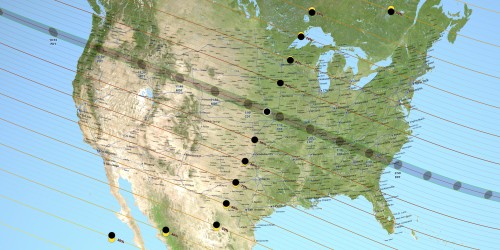
Night in day: the Sun will be temporarily blocked from view. (Courtesy: NASA)
By David Appell in Salem, Oregon, US
On Monday 21 August tens of millions of people will view one of the most remarkable phenomena available on Earth – a total solar eclipse. The shadow created as the Moon blocks out the Sun will sweep across the US in the middle of the day and I’ve been looking forward to it since I learned of it six years ago.
I’m one of the lucky ones – I live in Salem, Oregon, which lies within the eclipse’s 10 km-wide path of totality. Along this path, day will turn dark for about two minutes and the flare of the Sun’s corona will become visible. Birds will roost, crickets will begin to chirp, the temperature will fall about 5 °C, and people will likely gape in awe as humans have no doubt done since our species first began.
The path of totality will cover other prominent places in the US, including Jackson Hole in Wyoming, Kansas City in Missouri, and, last of all, Charleston in South Carolina. More than 12 million people are directly in the path, with 324 million within a 9-hour drive of it.
While all North Americans will see at least a partial eclipse with a minimum 60% blockage, here in Oregon we have a distinct advantage as well as totality – usually clear summer days (our reward for the other eight months of sprinkles, mist, drizzle and rain). The totality shadow – called the eclipse’s “umbra” – first touches land at Oregon’s coast and its edge will move eastward at up to 3900 km/hr. Here in Salem, the Moon will begin to cover the Sun at 9.05 a.m., with totality at 10.18 a.m., lasting one minute and 54 seconds.

The shadow’s path: everyone in North America will experience a partial eclipse. (Courtesy: NASA)
Astronomers say the umbra is the place to be. My sister and her family are coming down from Portland, tenting in my backyard, then after breakfast we’ll go to a park across the street to watch. I bought eclipse glasses months ago; if I have any luck left we’ll get a clear sky.
Oregon officials expect hundreds of thousands of visitors to travel into the state’s path of totality (an Oregon tourist official told me they expect about one million people), likely overwhelming roads, rural towns, cell phone networks, and bathroom facilities. Six helicopters will be on standby to carry first responders above the gridlock. One police official said traffic could be jammed for a week, and Salem has opened its parks to camping with no permit required. I’m glad I can just walk out my front door.
Stay tuned for another blog on the science planned for the eclipse.
Trackback: Blog - physicsworld.com